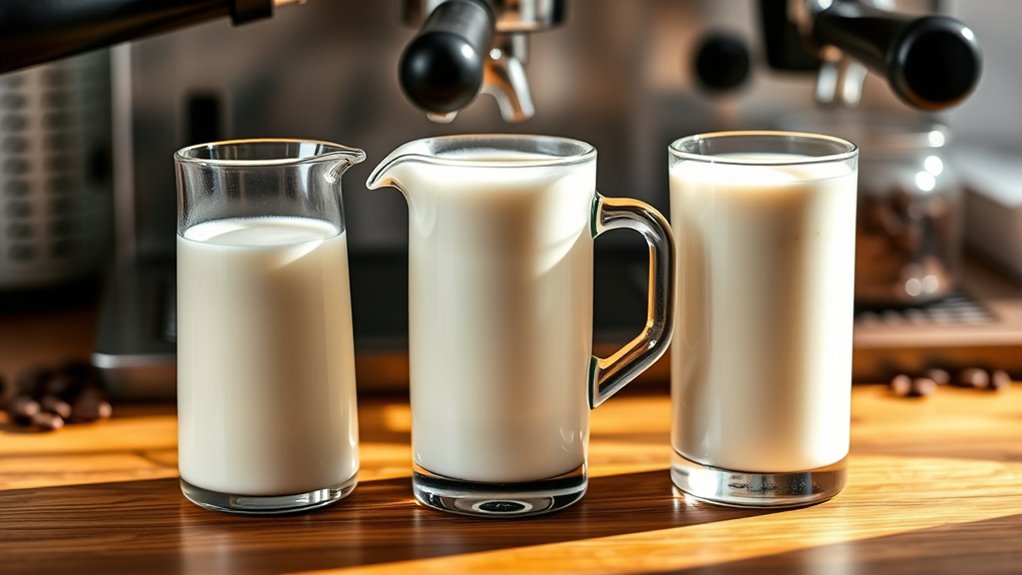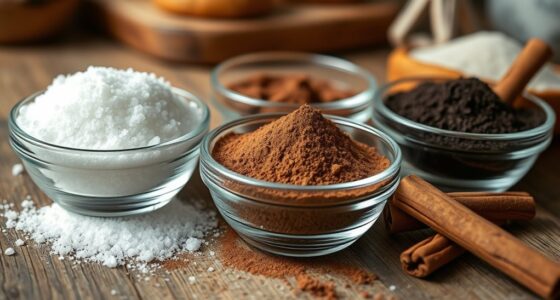When choosing milk for your cappuccino, consider your taste preferences and dietary needs. Whole milk gives you a rich, creamy foam perfect for classic drinks, while skim milk provides a lighter alternative with less fat. Plant-based options like almond, soy, or oat milk can add unique flavors and textures, though they may froth differently. Your ideal choice depends on your personal taste—keep exploring these options to find the perfect fit for your coffee experience.
Key Takeaways
- Whole milk offers richer flavor and creamier foam, ideal for traditional cappuccinos.
- Skim milk creates lighter foam with fewer calories, suitable for a milder taste.
- Plant-based alternatives like almond, soy, and oat milk vary in frothing ability and flavor profiles.
- Dairy milk generally produces more stable, velvety foam compared to many plant-based options.
- Choose milk based on dietary needs, flavor preference, and desired foam texture for the best cappuccino experience.

Have you ever wondered which type of milk is best for you? Choosing the right milk for your cappuccino involves understanding your options. When you look at dairy milk options, you’ll find a range of choices, from whole milk to skim milk, each offering different flavors, textures, and nutritional profiles. Whole milk provides a rich, creamy base that gives your cappuccino a full-bodied taste and velvety foam, perfect if you prefer a fuller flavor. Skim milk, on the other hand, has less fat and fewer calories, resulting in a lighter foam and a slightly milder taste. Deciding between these depends on your taste preferences and dietary needs, but both are staples for traditional coffee drinks.
Beyond dairy, plant-based milk varieties have gained popularity for their variety and suitability for different diets. Almond milk, soy milk, oat milk, and coconut milk are some common options, each bringing unique qualities to your cappuccino. Almond milk offers a nutty flavor and light texture, making it a good choice if you want a subtle taste that doesn’t overpower your coffee. Soy milk has a creamier consistency and a neutral flavor that closely mimics dairy in texture, making it ideal for creating a frothy, latte-like foam. Oat milk is renowned for its natural sweetness and creaminess, which can enhance the richness of your cappuccino while adding a smooth, velvety foam. Coconut milk imparts a tropical twist, with a subtle coconut flavor that complements certain coffee profiles, though it may be less traditional for classic cappuccinos.
When choosing between dairy milk options and plant-based varieties, think about your dietary restrictions, taste preferences, and the kind of foam you want. Dairy milk tends to produce a richer, creamier foam that’s favored in traditional cappuccinos, but plant-based alternatives have made great strides in texture and flavor, making them suitable for many coffee lovers. Some plant-based milks froth more easily than others, so it’s worth experimenting to find which one suits your brewing style. Additionally, understanding the spontaneous formation of dreams can sometimes reveal subconscious preferences or aversions related to your dietary choices, adding an unexpected layer to your coffee ritual. Ultimately, the best milk for your cappuccino depends on what you enjoy most—whether that’s the classic richness of whole dairy milk, the lightness of skim, or the diverse flavors of plant-based options. Exploring different types can elevate your coffee experience and help you craft your perfect cup.
Frequently Asked Questions
How Does Milk Temperature Affect Cappuccino Foam Quality?
Milk temperature directly impacts foam stability and quality in your cappuccino. If you heat the milk too much, it can scald, causing the foam to become grainy and unstable. Ideally, you want to steam milk to around 150-155°F (65-68°C), which creates dense, creamy foam that holds its shape. Proper temperature guarantees your foam remains silky, stable, and perfect for latte art or a smooth, creamy cappuccino experience.
Can Plant-Based Milks Be Steamed Like Dairy Milk?
A wise person once said, “Where there’s a will, there’s a way.” Yes, you can steam plant-based milk like dairy milk. With proper steaming techniques, such as adjusting temperature and aeration, plant-based milks like almond, soy, or oat can produce creamy foam. Keep in mind, each type may behave a little differently, so experiment to find the perfect technique for your favorite plant-based milk.
Which Milk Type Is Best for Creating Latte Art?
For creating latte art, dairy milk typically works best because of its superior foam stability, allowing you to craft intricate designs. If you’re using plant-based milk, opt for ones like oat or soy, which often produce better foam and hold their shape longer. Dairy versus plant-based milk impacts your art’s quality; choose the one that offers the best foam stability for smooth, detailed designs.
How Do Additives Like Flavorings Impact Milk Frothing?
Additives like flavorings can affect milk frothing by altering the flavoring effects and additive stability. When you add flavorings, they may weaken the foam’s structure or cause it to deflate faster if they’re not stable. To guarantee good frothing, choose flavorings with stable additives that blend well without compromising foam quality. Always test small amounts first to see how the flavoring impacts your milk’s frothing ability.
Are There Health Benefits Associated With Different Milk Choices?
Think of choosing milk as selecting a treasure chest. Whole milk offers nutritional advantages like calcium and vitamin D, supporting your bones. Skim milk provides fewer calories, ideal for weight management. Alternatives like almond or soy milk cater to allergen concerns and plant-based diets. Each choice benefits your health differently, so pick what aligns with your needs—just like finding the perfect treasure for your well-being.
Conclusion
Now that you know your milk options, selecting the perfect one for your cappuccino is like finding the missing piece of a puzzle. Whether you prefer the rich creaminess of whole milk, the lightness of skim, or plant-based alternatives, each choice adds its own flavor to your cup. So go ahead, experiment and discover which milk sings best to your taste buds. Your perfect cappuccino is waiting—just like a melody enthusiastic to be played.









